20.4. Reading Email Mail puts all the email you get into your Inbox; the statistic after the word Inbox lets you know how many messages you haven't yet read. New messages are also marked with light blue dots in the main list.
Tip: The Mail icon in the Dock also shows you how many new messages you have waiting ”it's the number in the red circle.
Click the Inbox folder to see a list of received messages. If it's a long list, press Control-Page Up and Control-Page Down to scroll. Click the name of a message once to read it in the Preview pane, or double-click a message to open it into a separate window. (If a message is already selected, pressing Return or Enter also opens its separate window.)
Tip: Instead of reading your mail, you might prefer to have Mac OS X read it to you, as you sit back in your chair and sip a strawberry daiquiri. Highlight the text you want to hear (or choose Edit Select All), and then choose Edit Speech Start Speaking. You'll hear the message read aloud , in the voice you've selected on the Speech pane of System Preferences (Chapter 9).To stop the insanity, choose Edit Speech Stop Speaking.
GEM IN THE ROUGH
All the Little Symbols | | The first column of the main email list shows little symbols that let you know at a glance how you've processed certain messages. The most common one is, of course, the light-blue dot (  ), which means "new message." (After reading a message, you can mark it once again as an unread message by choosing Message Mark As Unread [Shift-c-U] ”or by Control-clicking the message's name and choosing Mark As Unread from the shortcut menu.) ), which means "new message." (After reading a message, you can mark it once again as an unread message by choosing Message Mark As Unread [Shift-c-U] ”or by Control-clicking the message's name and choosing Mark As Unread from the shortcut menu.) You might also see these symbols, which represent messages that you've replied to (  ) , forwarded ( ) , forwarded (  ) , redirected ( ) , redirected (  ), or flagged ( ), or flagged (  ). ). A well- guarded secret, however, is that the "replied to" and "forwarded" symbols aren't just indicators ”they're buttons . When you see one of these symbols next to your original message, click it to jump straight to your reply (or forwarded message). You're spared the trouble of having to search through all your mailboxes. Incidentally, you may have noticed that Mail marks a message as having been read the moment you click it. You can change it back to unread by using its shortcut menu ”but there's also a more permanent workaround. If you hide the Preview pane by double-clicking the divider bar just above it, Mail no longer marks messages "read" just because you clicked them in the list. (You can bring back the Preview pane by double-clicking just above the vertical scroll bar, or by dragging the divider bar back up from the bottom.) |
Once you've viewed a message, you can respond to it, delete it, print it, file it, and so on. The following pages should get you started. 20.4.1. Threading Threading is one of the most useful mail-sorting methods to come along in a long time ”and it's available in Mail. When threading is turned on, Mail groups emails with the same subject (like "Raccoons" and "Re: Raccoons") as a single item in the main mail list. 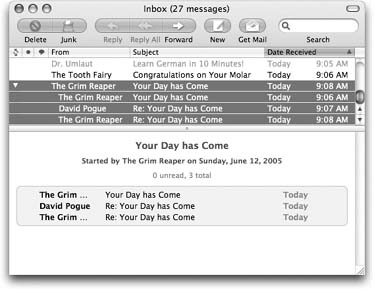 | Figure 20-7. Threads have two parts : a heading (the subject of the thread, listed in dark blue when it's not selected) and members (the individual messages in the thread, listed in light blue and indented). Often, the main list shows only a thread's heading; click the flippy triangle to reveal its members . | |
To turn on threading, choose View Organize by Thread. If several messages have the same subject, they all turn light blue to indicate their membership in a thread (see Figure 20-7). Here are some powerful ways to use threading: -
View a list of all the messages in a thread by clicking its heading. In the Preview pane, you'll see a comprehensive inventory of the thread (Figure 20-7). You can click a message's name in this list to jump right to it. -
Move all the members of a thread to a new mailbox by moving just its heading. You might find this useful, for example, when you've just finished a project and want to file away all the email related to it quickly. (As a bonus, a circled number tells you how many messages you're moving as you drag the heading.) You can even delete all the messages in a thread at once by deleting its heading. -
Examine thread members from multiple mailboxes . Normally, threads only display messages held in the same mailbox, but that's not especially convenient when you want to see both messages (from your Inbox) and your replies (in your Sent box). To work around that problem, click Inbox and then c-click the Sent mailbox (or any other mailboxes you want to include). Your threads will seamlessly combine related messages from all of the selected mailboxes. -
Quickly collapse all threads by choosing View Collapse All Threads. If your main list gets cluttered with too many expanded threads, this is a quick way to force it into order. (If, on the other hand, your main list isn't cluttered enough , choose View Expand All Threads.) -
Send someone all the messages in a thread by selecting the thread's heading and clicking Forward. Mail automatically copies all the messages of the thread into a new message, putting the oldest at the top. You might find this useful when you want to send your boss all the correspondence you've had with someone about a certain project. 20.4.2. Adding the Sender to Your Address Book When you choose the Message Add Sender To Address Book command, Mail memorizes the email address of the person whose message is on the screen. In fact, you can highlight a huge number of messages and add all the senders simultaneously using this technique. Thereafter, you'll be able to write new messages to somebody just by typing the first few letters of the name or email address. 20.4.3. Opening Attachments Just as you can attach files to a message, so people often send files to you. Sometimes they don't even bother to type a message; you wind up receiving an empty email message with a file or two attached. Only the presence of the file's icon in the message body tells you that there's something attached.
Tip: Mail doesn't ordinarily indicate the presence of attachments in the Messages list. It can do so, however. Just choose View Columns Attachments. A new column appears in the email list ”at the far right ”where you'll see a paper-clip icon and the number of file attachments listed for each message.
Mail doesn't store downloaded files as normal file icons on your hard drive. They're actually encoded right into the .mbox mailbox databases described on Section 20.4.12. To extract an attached file from this mass of software, you must proceed in one of these ways: -
Control-click the attachment's icon, and choose Save Attachment from the shortcut menu. You'll be asked to specify where you want to put it. -
Drag the attachment icon out of the message window and onto any visible portion of your desktop (or any visible folder). -
Click the Save button at the top of the email, or choose File Save Attachments. (If the message has more than one attachment, this maneuver will save all of them.)
Tip: The Save button at the top of the Preview pane doubles as a pop-up menu; if you hold down the mouse over it, you can select from several other options for saving the attachments ”like importing them into iPhoto or downloading only one of them.
-
Double-click the attachment's icon, or single-click the blue link underneath the icon. If you were sent a document (a photo, Word file, Excel file, and so on), it now opens in the corresponding program (Preview, Word, Excel, or whatever).
Warning: After the attachment is open, use the File Save As command to save the file into a folder of your choice. Otherwise, any changes you make to the document won't be visible in the file except when you open it from within Mail.
TROUBLESHOOTING MOMENT
Dial-up Blues | | If you're among the 50 percent of the population who still connects to the Internet with a dial-up modem, you may find that Mail is painfully slow at opening and reading email ”and that it slows down other Internet programs, like your Web browser, whenever it checks for new mail. Fortunately, you can take a few steps to speed up Mail (and, indirectly, your other Internet applications): Cut back on mail checks. Choose Mail Preferences, click General, and change the "Check for new mail" pop-up to "Every hour ," or even "Manually." That way, Mail won't tie up your phone line by trying to connect every five minutes. Whenever you have a choice, don't sign up for HTML email. HTML mail takes far longer to arrive than plain email. Even though Mail uses Safari's super- fast HTML-displaying technology, formatted messages still take far more time to download. Therefore, if you ever sign up for companies' email updates (like Apple's eNews bulletin or the New York Times' Circuits newsletter), choose to receive the messages as text, not HTML. Turn off graphics in formatted mail. If you have no choice but to receive HTML messages, the least you can do is block the pictures, which are the biggest and slowest elements of a formatted message. To do that, choose Mail Preferences, click Viewing, and turn off "Display images and embedded objects in HTML messages." From now on, you'll see a special Load Images button at the top of the Preview pane whenever you select an HTML message. If you feel that the empty boxes (where the graphics would have appeared) really deprive the message of its oomph, click that button to make Mail download all the images in the current message ”this time, only because you've asked for them. Don't auto-download attachments. If you use an IMAP, .Mac, or Exchange account, you can set up Mail so it won't download attachments until you tell it to. Open the Accounts pane of Mail's preferences, select your account, click Advanced, and choose "All messages, but omit attachments" from the pop-up menu in the middle. From now on, Mail won't save attachments unless you command it to do so. |
-
Control-click the attachment's icon. From the shortcut menu, you can specify which program you want to use for opening it, using the Open With submenu.
Tip: If the attachments you want to open are just pictures, you don't have to open them in a separate program at all. Tiger's Slideshow button can play a full-screen slideshow of every attached image.If you jiggle the mouse a little during the slideshow, you get a useful row of buttons along the bottom of the screen, too. Fit to Screen, for example, makes small images bigger, and Index Sheet gives you an Expos -like view of all the attached images at once.And if you want to show off to your PC-using friends , click Add to iPhoto. The current image slickly slides to the bottom of the screen ”and gets copied to iPhoto in the background, without even disrupting the progress of your slideshow.
20.4.3.1. When attachments don't open If you're unable to open a file attachment, there are several possible reasons. For starters, your correspondent's email program may have compressed or encoded the file so it takes less time to send. If you're having trouble getting a file to open, therefore, your first step should be to drag the attachment's icon onto that of StuffIt Expander, a little program that can gracefully decode just about any geeky Internet file. (See Section 2.8 for details on getting Expander.)
Tip: If you'd like to join the ranks of real Mac OS X masters, parking Expander in the Dock for easy drag-and-drop access is a good first step.
If the file still won't open, then you may be dealing with a file from a Windows PC that requires a little more effort to open. For example: -
.exe . This denotes an executable file ”in other words, a Windows program. By itself, your Mac can't run Windows programs, any more than a CD player can play 8-track tapes. To open Windows programs, however, you can use a Windows emulator like Virtual PC. -
.html . A file whose name ends in .html or .htm is a Web page. In the beginning, Web pages hung out only on the Internet. These days, however, you're increasingly likely to find that you've downloaded one to your Mac's hard drive. (It may be a software manual for some shareware, for example.) You can open it by double-clicking; Mac OS X comes set to open all .htm and .html files in Safari. -
.vcf . A "business-card" file; see Section 20.6.1.1. If you've received a file with a three-letter code not listed here, you may well have a file that can be opened only by a Windows program that you don't own. You might consider asking your correspondent to resend it in one of the more universal formats, such as the graphics formats JPEG and TIFF, or the text formats RTF and TXT. (Mac OS X opens all of these formats easily.) In addition, just about any layout, graphics, or text file can be turned into a PDF; if you're still having trouble opening the attachment, ask your correspondent to send the attachment in that format instead. 20.4.4. Replying to a Message To answer a message, click the Reply button on the message toolbar (or choose Message Reply, or press c-R). If the message was originally addressed to multiple recipients, you can send your reply to everyone simultaneously by clicking Reply All instead. A new message window opens, already addressed. As a courtesy to your correspondent, Mail places the original message at the bottom of the window, denoted by a vertical bar, as shown in Figure 20-8. 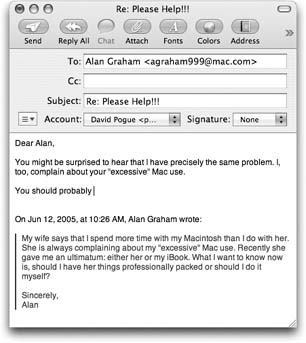 | Figure 20-8. In Rich Text “formatted Mail messages (not to be confused with RTF [Rich Text Format] word processing format, which is very different), a reply includes the original message, marked in a special color (which you can change in Mail Preferences) and with a vertical bar to differentiate it from the text of your reply. (In plain-text messages, each line of the reply is >denoted >with >brackets, although only your recipient will see them.) The original sender's name is automatically placed in the "To:" field. The subject is the same as the original subject with the addition of Re: (shorthand for Regarding). You're now ready to type your response. | |
Tip: If you highlight some text before clicking Reply, Mail pastes only that portion of the original message into your reply. That's a great convenience to your correspondent, who now knows exactly which part of the message you're responding to.
At this point, you can add or delete recipients, edit the Subject line or the original message, attach a file, and so on.
Tip: Use the Return key to create blank lines in the original message. Using this method, you can splice your own comments into the paragraphs of the original message, replying point by point. The brackets preceding each line of the original message help your correspondent keep straight what's yours and what's hers.
When you're finished, click Send. (If you click Reply All in the message window, your message goes to everyone who received the original note, even if you began the reply process by clicking Reply. Mac OS X, in other words, gives you a second chance to address your reply to everyone.) 20.4.5. Forwarding Messages Instead of replying to the person who sent you a message, you may sometimes want to pass the note on to a third person. To do so, click the Forward toolbar button (or choose Message Forward, or press Shift-c-F). A new message opens, looking a lot like the one that appears when you reply. You may wish to precede the original message with a comment of your own, along the lines of: "Frank: I thought you'd be interested in this joke about your mom." Finally, address it as you would any outgoing piece of mail. 20.4.6. Redirecting Messages A redirected message is similar to a forwarded message, with one extremely useful difference. When you forward a message, your recipient sees that it came from you. When you redirect it, your recipient sees the original writer's name as the sender. The message bears no trace of your involvement (unless the recipient thinks to choose View Message Long Headers). In other words, a redirected message uses you as a low-profile relay station between two other people. Treasure this feature. Plenty of email programs, including Outlook and Outlook Express for Windows, don't offer a Redirect command at all. You can use it to transfer messages from one of your own accounts to another, or to pass along a message that came to you by mistake. To redirect a message, choose Message Redirect, or press Shift-c-E. You get an outgoing copy of the message ”this time without any quoting marks. (In Tiger, you can edit redirected messages before you send them, too, which is perfect for April Fools' Day pranks .) 20.4.7. Printing Messages Sometimes there's no substitute for a printout. Choose File Print, or press c-P to summon the Print dialog box. 20.4.8. Filing Messages Mail lets you create new mailboxes in the Mailboxes column. You might create one for important messages, another for order confirmations from Web shopping, still another for friends and family, and so on. You can even create mailboxes inside these mailboxes, a feature beloved by the hopelessly organized. Mail in Tiger even offers smart mailboxes ”self-updating folders that show you all your mail from your boss, for example, or every message with "mortgage" in its subject. It's the same idea as smart folders in the Finder (Section 3.4.3.8) or smart playlists in iTunes (Section 11.3.8.1): folders whose contents are based around criteria that you specify (Figure 20-9). 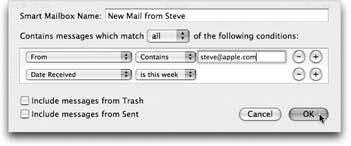 | Figure 20-9. Just like iTunes, iPhoto, and the Finder, Mail lets you create self-populating folders. In this example, the "New Mail from Steve" smart mailbox will automatically display all messages from Steve Jobs at Apple that you've received in the past week. | |
The commands you need are all in the Mailbox menu. For example, to create a new mailbox folder, choose Mailbox New Mailbox, or click the + button at the bottom of the drawer . To create a smart mailbox, choose Mailbox New Smart Mailbox. Mail asks you to name the new mailbox. If you have more than one email account, you can specify which one will contain the new folder. (Smart mailboxes, however, always sit outside your other mailboxes.)
Tip: If you want to create a folder-inside-a-folder, use slashes in the name of your new mail-box. (If you use the name Cephalopods/Squid , for example, Mail will create a folder called Cephalopods, with a subfolder called Squid.) You can also drag the mailbox icons up and down in the drawer to place one inside another.None of those tricks work for smart mailboxes, however. The only way to organize smart mailboxes is to put them inside a smart mailbox folder , which you create using Mailbox New Smart Mailbox. You might do that if you have several smart mailboxes for mail from your coworkers ("From Jim," "From Anne," and so on) and want to put them together in one collapsible group to save screen space.
When you click OK, a new icon appears in the mailbox drawer, ready for use. You can move a message (or group of messages) into a mailbox folder in any of three ways: -
Drag it out of the main list onto the mailbox icon (Figure 20-10). -
In the list pane, highlight one or more messages, and then choose from the Message Move To submenu, which lists all your mailboxes. -
Control-click a message (or one of several that you've highlighted). From the resulting shortcut menu, choose Move To, and then, from the submenu, choose the mailbox you want. 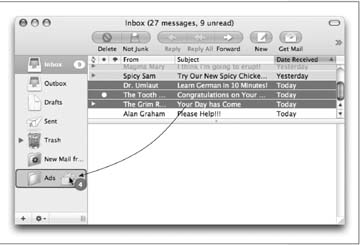 | Figure 20-10. You can use any part of a message's "row" in the list as a handle; the envelope cursor tells you that Mail knows what's happening. You can also drag messages en masse onto a folder. If you Option-drag a message into a folder, you make a copy, leaving the original message where it is. | |
Of course, the only way to change the contents of a smart mailbox is to change the criteria that it uses to populate itself. To do so, double-click the smart mailbox icon and use the dialog box that appears. 20.4.9. Flagging Messages Sometimes you'll receive email that prompts you to some sort of action, but you may not have the time (or the fortitude) to face the task at the moment. ("Hi there it's me, your accountant . Would you mind rounding up your expenses for 1995 through 2005 and sending me a list by email?") That's why Mail lets you flag a message, summoning a little flag icon in a new column next to a message's name. These indicators can mean anything you like ”they simply call attention to certain messages. You can sort your mail list so that all your flagged messages are listed first; click the flag at the top of the column heading. To flag a message in this way, select the message (or several messages) and choose Message Mark As Flagged, or press Option-c-L, or Control-click the message's name in the list and, from the shortcut menu, choose Mark As Flagged. (To clear the flags, repeat the procedure, but use the Mark As Unflagged command instead.)
Tip: This whole flagging business has another useful side effect. If you have any messages that Mail thinks are spam, they'll be listed with little trash-bag icons in the flag column. If you sort your mail by flag, then, all your spam will be grouped together ”which is great if you want to do one big spam-cleaning by dragging it all to the Trash.
20.4.10. Finding Messages As noted earlier in this chapter, you can sort the columns in your main email list just by clicking the headings (From, Subject, Date & Time, and so on). The smart mail-box feature described on Section 20.4.5 is another useful way of sorting your messages, provided you know that you're going to be looking for the same kind of messages over and over again. But when you deal with masses of email, you may find it easier to process your messages using Mail's dedicated searching tools. They're fast and convenient, and when you're done with them, you can go right back to browsing your Message list as it was. 20.4.10.1. Finding messages within a mailbox See the little text box in the upper-right corner of your main mail window? You can use it to hide all but certain messages, as shown in Figure 20-11. 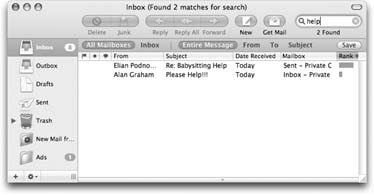 | Figure 20-11. You can jump to the search box by clicking or by pressing Option-c-F. As you type, Mail shrinks the list of messages to include only the matches. You can fine-tune your results using the buttons just above the list. To return to the full message list, click the tiny X at the right side of the search box. | |
Tip: You can also set up Mail to show you only certain messages that you've manually selected, hiding all others in the list. To do so, highlight the messages you want, using the usual selection techniques (Section 2.3). Then choose View Display Selected Messages Only. (To see all of them again, choose View Display All Messages.)
In Tiger, this search field is more powerful than ever. For example: -
When you're searching, a thin row of buttons appears underneath the toolbar. You can use these buttons to narrow your results to only messages with your search term in their subject , for example, or to only those messages in the currently selected mailbox. -
When you select a message in the search view, the Preview pane pops up from the bottom of the window. If you click Show in Mailbox, on the other hand, you exit the search view and jump straight to the message in whatever mailbox it came from. That's perfect if the message is part of a thread, since jumping to the message will also display all the other messages from its thread. -
If you think you'll want to perform the current search again sometime, click Save in the upper-right corner of the window. Mail displays a dialog box with your search term and criteria filled in; all you have to do is give it a name and click OK to transform your search into a smart mailbox that you can open any time. 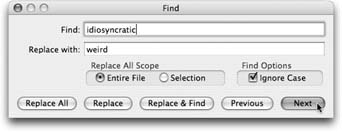 | Figure 20-12. The Find dialog box works just as it does in a word processor like TextEdit, except that the Replace function works only on messages that you have written yourself ”Mail doesn't let you change the words of mail you've received. (Lawyers would have a field day with that in court .) | |
20.4.10.2. Finding text within an open message You can also search for certain text within a single message. Choose Edit Find Find (or press c-F) to bring up the Find dialog box (Figure 20-12). 20.4.11. Deleting Messages Sometimes it's junk mail. Sometimes you're just done with it. Either way, it's a snap to delete a selected message, several selected messages, or a message that's currently before you on the screen. You can press the Delete key (with or without the c key), click the Delete button on the toolbar, choose Edit Delete, or drag messages out of the list window and into your Trash mailbox ”or even onto the Dock's Trash icon.
Tip: If you delete a message by accident , the Undo command (Edit Undo or c-Z) restores it.
All of these commands move the messages to the Trash folder. If you like, you can then click its icon to view a list of the messages you've deleted. You can even rescue messages by dragging them back into another mailbox (back to the Inbox, for example). 20.4.11.1. Method 1: Emptying the Trash folder Mail doesn't vaporize messages in the Trash folder until you "empty the trash," just like in the Finder. You can empty the Trash folder in any of several ways: -
Click a message (or several) within the Trash folder list and then click the Delete icon on the toolbar (or press the Delete key). Now those messages are really gone. -
Choose Mailbox Erase Deleted Messages (c-K). (If you have multiple accounts, choose Erase Deleted Messages In All Accounts.) -
Control-click the Trash mailbox icon and choose Erase Deleted Messages from the shortcut menu. (Mail sports an Action pop-up icon at the bottom, too, just like the Finder toolbar. For example, you can also choose Erase Deleted Messages from this pop-up menu.) -
Wait. Mail will permanently delete these messages automatically after a week. If a week is too long (or not long enough), you can change this interval. Choose Mail Preferences, click Accounts, and select the account name from the list at left. Then click Mailbox Behaviors, and change the "Erase deleted messages when" pop-up menu. If you choose Quitting Mail from the pop-up menu, Mail will take out the trash every time you quit the program. 20.4.11.2. Method 2: Deleted mail turns invisible Mail offers a second ”and very unusual ”method of deleting messages that doesn't involve the Trash folder at all. Using this method, pressing the Delete key(or clicking the Delete toolbar button) simply hides the selected message in the list. Hidden messages remain hidden, but don't go away for good until you use the Rebuild Mailbox command described in the box on Section 20.5.2. TROUBLESHOOTING MOMENT
Secrets of the Mbox Files | | As noted earlier in this chapter, Mail keeps your messages in a series of mailbox database files in your Home Library Mail Mailboxes folder, inside folders named for your accounts (Outbox, Deleted Messages, and so on). Knowing this permits you to perform a number of interesting tricks. First of all, now you know what files to back up for safekeeping. Second, you now have yourself a beautiful monthly archiving system. Each month, you can create a new mailbox folder in Mail, named for that month (like "June2004.mbox"). Drag into it all the mail you want to archive, and then back up only that mailbox file from your hard drive ”instant archiving system! (If you ever want to work with these messages again, just drag that .mbox file back into your Home Library Mail folder before opening Mail.) Third, now you know which files to copy to your laptop to maintain email continuity when you travel. And finally, if you have messages on an old Mac that you'd like to copy to your new one, you know where they're stored. |
If this arrangement sounds useful, choose Mail Preferences, click Accounts, select the account from the list on the left, click Mailbox Behaviors, and turn off the checkbox called "Move deleted messages to a separate folder" or "Move deleted messages to the Trash mailbox." (The checkbox's wording depends on what kind of account you have.) From now on, messages you delete vanish from the list.  | Figure 20-13. To resurrect a deleted message (indicated in light gray type), Control-clicking it and choose Undelete from the shortcut menu. | |
They're not really gone, however. You can bring them back, at least in ghostly form, by choosing View Show Deleted Messages (or pressing c-L). Figure 20-13 shows the idea. Using this system, in other words, you never truly delete messages; you just hide them. At first, you might be concerned about the disk space and database size involved in keeping your old messages around forever like this. Truth is that Mac OS X is perfectly capable of maintaining many thousands of messages in its mailbox databases ”and with the sizes of hard drives nowadays, a few thousand messages isn't likely to make much of a dent. Meanwhile, there's a huge benefit to this arrangement. At some point, almost everyone wishes they could resurrect a deleted message ”maybe months later, maybe years later. Using the hidden-deleted-message system, your old messages are always around for reference. (The downside to this system, of course, is that SEC investigators can use it to find incriminating mail that you thought you'd deleted.) When you do want to purge these messages for good, you can always return to the Special Mailboxes dialog box and turn the "Move deleted mail to a separate folder" checkbox back on. 20.4.12. Using Message Rules Once you know how to create folders, the next step in managing your email is to set up a series of message rules (filters) that file, answer, or delete incoming messages automatically based on their contents (such as their subject, address, and/or size). Message rules require you to think like the distant relative of a programmer, but the mental effort can reward you many times over. Message rules turn Mail into a 20.4.12.1. Setting up message rules Here's how to set up a message rule: 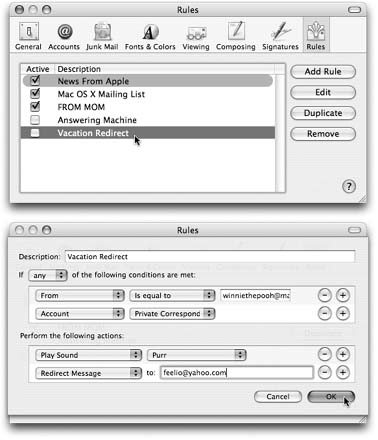 | Figure 20-14. Top: Mail rules can screen out junk mail, serve as an email answering machine, or call important messages to your attention. All mail message rules you've created appear in this list. (The color shading for each rule is a reflection of the colorizing options you set up, if any.)
Bottom: Double-click a rule to open the Edit Rule dialog box, where you can specify what should set off the rule and what it should do in response. | |
-
Choose Mail Preferences, and then click the rules icon . The Rules pane appears, as shown at top in Figure 20-14. -
Click Add rule . Now the dialog box shown at bottom in Figure 20-14 appears. -
Use the criteria options (the ones at the top) to specify how Mail should select messages to process . For example, if you'd like the program to watch out for messages from a particular person, you would set up the first two pop-up menus to say "From" and "Contains," respectively. To flag messages containing loan, $$$$, XXXX, !!!! , and so on, set the pop-up menus to say "Subject" and "Contains." You can set up multiple criteria here, so you flag messages whose subjects contain any one of those common spam triggers. (If you change the "any" pop-up menu to say "all," then all of the criteria must be true for the rule to kick in.) -
Specify which words or people you want the message rule to watch for . In the text box to the right of the two pop-up menus, type the word, address, name, or phrase you want Mail to watch for ”a person's name, or $$$$ , in the previous examples. -
In the lower half of the box, specify what you want to happen to messages that match the criteria . If, in Steps 1 and 2, you've told your rule to watch for junk mail containing $$$$ in the Subject line, here's where you can tell Mail to delete it or move it into, say, a Junk folder. With a little imagination , you'll see how the options in this pop-up menu can do absolutely amazing things with your incoming email. Mail can colorize, delete, move, redirect, or forward messages ”or even play a sound when you get a certain message. Consider, for example, what happens when you go on a trip. By setting up the controls as shown in Figure 20-14, you'll have specified that messages your boss, who calls himself Winnie the Pooh, sends to your .Mac account are to be redirected to your vacation email address, feelio@yahoo.com . (The rest of the mail will just have to wait until you're home again.) POWER USERS' CLINIC
The Email Answering Machine | | If you're going on vacation, you can turn Mail into an email answering machine that sends a canned "I'm away until the 15th" message to everyone who writes you. To do so, set the first set of pop-up menus in the Rules dialog box so that they say Account and the name of your account. In the bottom half of the dialog box, select reply to Message from the pop-up menu. Click "reply message text" and type your boilerplate reply in the resulting box. Keep in mind, though, that mail rules only work when Mail is open and connected to the Internet. If your computer is set to turn off after a certain period of time, therefore, make sure to disable that feature before you go on vacation. Also: If you subscribe to mailing lists, set up another mail rule that intercepts and files them before your answering-machine rule kicks in. Otherwise, you'll incur the wrath of other Internet citizens by littering their email discussion groups with copies of your auto-reply message. | -
In the very top box, name your mail rule. Click OK . Now you're back to the Rules pane (Figure 20-14, top). Here you can choose a sequence for the rules you've created by dragging them up and down. Here, too, you can turn off the ones you won't be needing at the moment, but may use again one day.
Tip: Mail applies rules as they appear, from top to bottom, in the list. If a rule doesn't seem to be working properly, it may be that an earlier rule is intercepting and processing some messages before the "broken" rule even sees it. To fix this, try dragging the rule up or down in the list.
|







